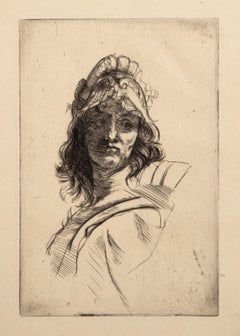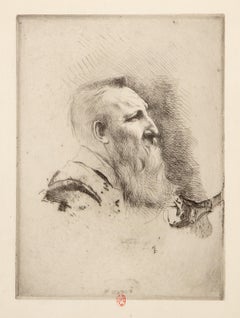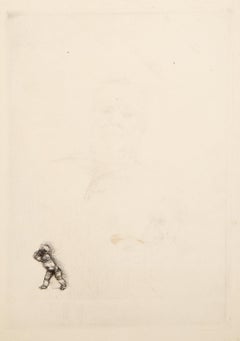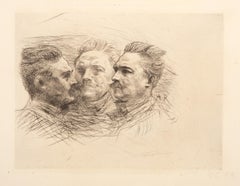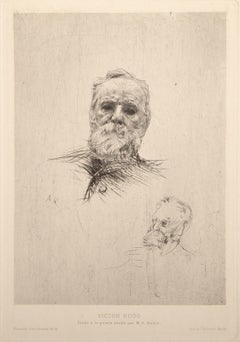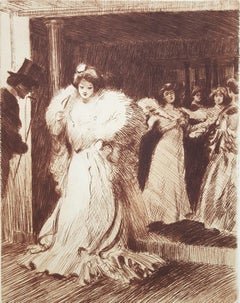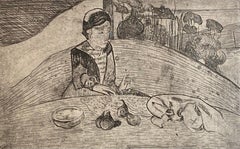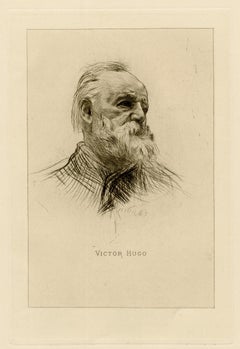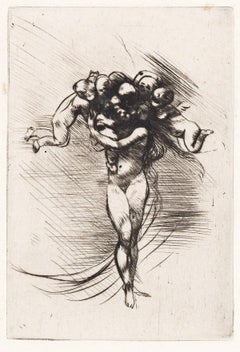Auguste Rodin Figurative Prints
French, 1840-1917
Auguste Rodin was a French sculptor widely regarded as the father of modern sculpture. Breaking away from the idealized forms of classical sculpture, Rodin introduced a more naturalistic, emotionally charged style that emphasized texture, movement, and human emotion. His work often explored themes of love, struggle, and the human condition.
Rodin's most iconic works include The Thinker, The Kiss, and The Gates of Hell, many of which began as smaller studies and evolved into monumental masterpieces. His innovative approach to form, fragmentation, and surface detail challenged traditional academic norms and set a new direction for modern sculpture.
Despite initial criticism and controversy, Rodin’s work was eventually celebrated as groundbreaking, and he achieved widespread recognition during his lifetime. Today, his sculptures are displayed in major museums and public spaces worldwide, symbolizing the transition from classical to modern art.to
6
1
Overall Width
to
Overall Height
to
3
3
31
859
382
371
308
7
6
1
6
6
5
4
1
1
7
6
1
Artist: Auguste Rodin
Dante & Virgilus - Etching, (Ed. Goupil, 1897)
By Auguste Rodin
Located in Paris, IDF
ARTISTE: after Auguste RODIN
TITLE : Dante & Virgilus
MEDIUM : Etching/photogravure after the original drawing
SIGNATURE : Unsigned
YEAR : 1897
PAPER : Vellum
SIZE : 13 x 10"
INFOR...
Category
1890s Academic Auguste Rodin Figurative Prints
Materials
Etching
Buste de Bellone, Modern Etching by Auguste Rodin
By Auguste Rodin
Located in Long Island City, NY
Auguste Rodin, French (1840 - 1917) - Buste de Bellone, Year: 1883, Medium: Etching on Japon, Image Size: 6 x 4 inches, Size: 13 x 9 in. (33.02 x 22.86 cm), Reference: Thorson 11, ...
Category
1880s Modern Auguste Rodin Figurative Prints
Materials
Etching
Albert Besnard, Modern Etching by Auguste Rodin
By Auguste Rodin
Located in Long Island City, NY
Auguste Rodin, French (1840 - 1917) - Albert Besnard, Year: circa 1885, Medium: Etching on Japon, Image Size: 10.75 x 7.75 inches, Size: 14 x 10.75 in. (35.56 x 27.31 cm), Descript...
Category
1880s Modern Auguste Rodin Figurative Prints
Materials
Etching
Victor Hugo, de Face State Nine, Impressionist Etching by Auguste Rodin
By Auguste Rodin
Located in Long Island City, NY
Auguste Rodin, French (1840 - 1917) - Victor Hugo, de Face State Nine, Year: 1885, Medium: Etching, Image Size: 8.75 x 6 inches, Size: 10.75 x 7 in. (27.31 x 17.78 cm), Reference: T...
Category
1880s Impressionist Auguste Rodin Figurative Prints
Materials
Etching
Henri Becque, Modern Etching by Auguste Rodin
By Auguste Rodin
Located in Long Island City, NY
Auguste Rodin, French (1840 - 1917) - Henri Becque, Year: 1885, Medium: Etching on Arches, initialed 'AR' in pencil lower right, Image Size: 5.75 x 7.5 inches, Size: 16.5 x 23 in. ...
Category
1880s Modern Auguste Rodin Figurative Prints
Materials
Etching
Victor Hugo, de Face (State 6), Impressionist Etching by Auguste Rodin
By Auguste Rodin
Located in Long Island City, NY
Auguste Rodin, French (1840 - 1917) - Victor Hugo, de Face (State 6), Year: 1885, Medium: Etching, signed in the plate, Image Size: 9 x 6.25 inches, Size: 17.25 x 11.75 in. (43.82 ...
Category
1880s Impressionist Auguste Rodin Figurative Prints
Materials
Etching
Victor Hugo, de Face (State 5), Impressionist Etching by Auguste Rodin
By Auguste Rodin
Located in Long Island City, NY
Auguste Rodin, French (1840 - 1917) - Victor Hugo, de Face (State 5), Year: 1885, Medium: Etching on Arches, signed in the plate, Edition: 60, Image Size: 8 x 6.25 inches, Size: 17...
Category
1880s Impressionist Auguste Rodin Figurative Prints
Materials
Etching
Related Items
L'Avant-Foyer de l'Opera /// French Impressionist Etching Figurative Lady Man
By Tony Minartz
Located in Saint Augustine, FL
Artist: Tony Minartz (French, 1873-1944)
Title: "L'Avant-Foyer de l'Opera"
Portfolio: Revue de l'Art Ancien & Moderne
*Issued unsigned
Year: 1903
Medium: Original Etching on cream laid paper
Limited edition: Unknown
Printer: Unknown
Publisher: Revue de l'Art Ancien & Moderne, Paris, France
Framing: Recently framed in a traditional gold and black moulding with 100% cotton rag matting
Framed size: 18.63" x 16.38"
Sheet size: 12" x 9"
Image size: 9" x 7.25"
Condition: In excellent condition
Notes:
Printed in one color: bistre.
This review was founded in 1897 in the continuity of the review Les Beaux-Arts published between 1861 and 1865; Jules Comte, the founder, entitled his first issue Les Beaux-Arts - Revue nouvelle then changed the title to La Revue de l'art ancien et moderne. Jules Comte directed the review until his death in 1912. Raymond Woog took over , who was provisional director until the start of the war in July 1914. In 1919, André Dezarrois took over this review and was its director until December 1937, date of last issue (published in January 1938). In the meantime, it publishes the Bulletin of ancient and modern art, which has gained a certain notoriety in the community.
Biography:
Tony Minartz, pseudonym of Antoine Guillaume, born 8 April 1873 to Cannes and died in that city on 13 December 1944 Is a painter, draftsman , illustrator and engraver French.
Painter autodidact , Tony Minartz starts to become known in 1896 by exhibiting paintings at the Salon of the National Society of Fine Arts , and then decorates the Pompadour theater of painted panels for fashion shows " Grand Guignol ", directed by L. Darthenay. In 1903, Henri Béraldi , with whom he worked, praised him in The Journal of ancient and modern art, writing that "it was thirty years ago," and he has received advice from Paul Renouard to be formed the technique of etching ; Béraldi adds that his favorite subjects are "Paris at night Paris at night, always." Minartz also gives them some high-remarkable in The Journal of ancient and modern art until 1910: balls, cafe concerts, Parisian in their most beautiful dresses, but also music-halls, music halls, restaurants, large and small theaters, are the preferred settings of his compositions.
Its fertile period seems to end in 1914. In addition to the National Salon, Minartz exhibited in Paris at the gallery Bartholomew (1903), the Independent Living (1905, 1906) and the gallery Devambez (1909) and received the Academic Palms . He occasionally collaborates with periodic illustrated as The Almanac Sports (Ollendorff, 1899), or satirical as Gil Blas...
Category
Early 1900s Impressionist Auguste Rodin Figurative Prints
Materials
Laid Paper, Intaglio, Etching
$350 Sale Price
54% Off
H 18.63 in W 16.38 in
“La Femme aux Figues”
By Paul Gauguin
Located in Southampton, NY
Original etching and lavis in black ink on Arches watermarked crème laid paper by Paul Gauguin. Titled: “La Femme aux Figues” (The Woman with Figs). This impression is from the 3rd s...
Category
1970s Academic Auguste Rodin Figurative Prints
Materials
Archival Paper, Etching
Une Femme Assise by Lucien Pissarro - Etching
By Lucien Pissarro
Located in London, GB
Une Femme Assise by Lucien Pissarro (1863-1944)
Etching
23 x 13 cm (9 x 5 ¹/₈ inches)
Stamped lower right, L.P. and numbered lower left, 10/20
Provenance: John Bensusan Butt
Private...
Category
1890s Impressionist Auguste Rodin Figurative Prints
Materials
Etching
"Le Petit Cirque Prinder, " Original Etching signd by Auguste Brouet
By Auguste Brouet
Located in Milwaukee, WI
"Le Petit Cirque Prinder" is an original etching by Auguste Brouet. This piece depicts a variety of circus performers surrounded by small children. The artist signed the piece in the...
Category
1910s Academic Auguste Rodin Figurative Prints
Materials
Pencil, Etching
$2,150
H 14 in W 17.625 in
Inside the castle by David Hockney (Six Fairy Tales from the Brothers Grimm)
By David Hockney
Located in New York, NY
From David Hockney’s celebrated Six Fairy Tales from the Brothers Grimm portfolio, an image of the story ‘The boy who left home to learn fear’. Hockney chose this story for its obscu...
Category
1960s Modern Auguste Rodin Figurative Prints
Materials
Etching, Aquatint
$2,250
H 17.75 in W 16 in
A la Corrida
Located in Fairlawn, OH
A la Corrida
Color aquatint, c. 1900
Signed "Osterlind" lower right in red pencil
Annotated: "No. 96" in pencil lower left
Edition: about 100
Published by Sagot, Paris: their blindst...
Category
Early 1900s Impressionist Auguste Rodin Figurative Prints
Materials
Aquatint
Vachère au Bord de l'Eau
By Camille Pissarro
Located in Santa Monica, CA
CAMILLE PISSARRO (French 1830-1903)
VACHERE au BORD de l’EAU 1890 (Delteil 93 viii/viii)
Etching, unsigned as published in “Gazette des Beaux Arts”, Paris, 1890. On laid paper
Very...
Category
1890s Impressionist Auguste Rodin Figurative Prints
Materials
Drypoint, Etching
Four Figures and a Head, on Giant Phallus by Claes Oldenburg erotic nude scene
By Claes Oldenburg
Located in New York, NY
This sensuous and playful scene is characteristic of Oldenburg’s printmaking ouevre: a veritable heap of women displaying various expressions of joy and come-hither coquettishness. T...
Category
1970s Modern Auguste Rodin Figurative Prints
Materials
Etching
“Le Chapeau Epingle”
By Pierre-Auguste Renoir
Located in Southampton, NY
Original etching and drypoint on wove paper. This is the third version and the second edition printed in 1921 of Le Chapeau Epingle. Condition is very good...
Category
1880s Impressionist Auguste Rodin Figurative Prints
Materials
Archival Paper, Etching
Billingsgate
By James Abbott McNeill Whistler
Located in Middletown, NY
Etching printed in dark brownish black ink on cream laid paper, 6 x 8 7/8 inches (152 x 226 mm); full margins. Extremely minor and unobtrusive band of toning along the top sheet edg...
Category
Mid-19th Century Impressionist Auguste Rodin Figurative Prints
Materials
Laid Paper, Drypoint, Etching
Rapunzel, Rapunzel, let down your hair David Hockney Brothers Grimm Fairy Tales
By David Hockney
Located in New York, NY
From David Hockney’s celebrated Six Fairy Tales from the Brothers Grimm portfolio, an image from the story of Rapunzel, which he chose for its popularity. When illustrating the princ...
Category
1960s Modern Auguste Rodin Figurative Prints
Materials
Etching, Aquatint
Buttercup Flowers: A Besler 18th Century Hand-colored Botanical Engraving
Located in Alamo, CA
This is a hand-colored copper plate engraving depicting Ranunculus (Persian Buttercup) flowers from Basilius Besler's landmark work, Hortus Eystettensis (Garden at Eichstatt), first published in 1613 in Eichstatt, Germany near Nuremberg and later in 1640 and 1713.
This beautiful colorful engraving is printed on thick laid chain-linked paper. There is latin text on the verso. There are central horizontal creases and two small holes on the right and another in the left lower corner. It is otherwise in excellent condition.
Basilius Besler (1561–1629) was an apothecary and botanist. He was curator of the Willibaldsburg Castle garden of Johann Konrad von Gemmingen, prince bishop...
Category
Early 18th Century Academic Auguste Rodin Figurative Prints
Materials
Engraving
Previously Available Items
Victor Hugo, de trois quarts
By Auguste Rodin
Located in Fairlawn, OH
Victor Hugo, de trois quarts
Etching & Drypoint, 1884
Unsigned (as issued)
Published in Geffroy, Le Statuaire Rodin, 1889
Printed on wove paper
Reference: Delteil 6 vi/VIII
Thorson 8 vi/VIII
Condition: Excellent
Victor-Marie Hugo (French: [viktɔʁ maʁi yɡo] (listen); 26 February 1802 – 22 May 1885) was a French Romantic writer and politician. During a literary career that spanned more than sixty years, he wrote in a variety of genres and forms. He is considered to be one of the greatest French writers of all time.
His most famous works are the novels The Hunchback of Notre-Dame (1831) and Les Misérables (1862). In France, Hugo is renowned for his poetry collections, such as Les Contemplations (The Contemplations) and La Légende des siècles (The Legend of the Ages). Hugo was at the forefront of the Romantic literary movement with his play Cromwell and drama Hernani. Many of his works have inspired music, both during his lifetime and after his death, including the opera Rigoletto and the musicals Les Misérables and Notre-Dame de Paris. He produced more than 4,000 drawings in his lifetime, and campaigned for social causes such as the abolition of capital punishment.
Though he was a committed royalist when young, Hugo's views changed as the decades passed, and he became a passionate supporter of republicanism, serving in politics as both deputy and senator. His work touched upon most of the political and social issues and the artistic trends of his time. His opposition to absolutism and his literary stature established him as a national hero. He was honoured by interment in the Panthéon.
Auguste Rodin (French, 1840–1917) was deeply inspired by tradition yet rebelled against its idealized forms. Over the course of a career that spanned the late 1800s and early 1900s, he introduced innovative practices that paved the way for modern sculpture. He believed that art should be true to nature, a philosophy that shaped his attitudes to models and materials.
Controversies surrounded certain of his works, such as the scandals around The Age of Bronze or the Monument to Honoré de Balzac, and for his unfinished projects, most famously The Gates of Hell, but few who recognize Rodin's sculptures have failed to be moved by them. His genius was to express inner truths of the human psyche, and his gaze penetrated beneath the external appearance of the world. Exploring this realm beneath the surface, Rodin developed an agile technique for rendering the extreme physical states that correspond to expressions of inner turmoil or overwhelming joy. He sculpted a universe of great passion and tragedy, a world of imagination that exceeded the mundane reality of everyday existence.
Rodin was not educated at the École des Beaux-Arts in Paris, the prestigious school for the training of French artists. But his focus on the human form and use of various materials such as bronze, marble, plaster, and clay illustrate his respect for sculptural tradition and his desire to work within the system for commissions and exhibition opportunities. The hallmarks of Rodin's style—his decision not to smooth over or hide signs of his sculptural process and the creation of sculptures from parts of the body like hands—were revolutionary in his time. The evocative intensity of his works were elaborated on by countless artists who followed him, including many who worked in his studio, such as Constantin Brancusi (French, born Romania, 1876–1957) and Aristide Maillol (French, 1861–1944).
In 1901, a friend suggested that Philadelphia body builder Samuel Stockton White 3rd (1876-1952) present himself to Rodin as a model. The artist was impressed by the young athlete’s physique and created these sculptures, which are visually related to The Thinker. The twenty-year gap between the two works highlights Rodin’s more relaxed approach toward figure modeling, the later work showing White resting rather than brooding. These bronzes reflect the twentieth-century taste for a new classicism in art, in which classical nude figures were reinterpreted as modern figures.
The Age of Bronze is the earliest surviving example of a life-sized sculpture by Rodin, which he began before leaving for Italy in late 1875 and completed after his return the following year. The figure’s musculature and underlying structures are so authentic that the work proved an artistic liability for Rodin, and he spent three years defending himself against the charge that he had cast it from a live model. This accusation was a great insult because it denied Rodin’s creative process, instead implying that he had done nothing more than simply make an impression of the model. Eventually a group of important artists sent a letter to the French government in the artist’s defense, and the French state ultimately bought The Age of Bronze and had it cast in bronze for the Paris Salon of 1880.
The Gates of Hell is the defining project of Rodin’s career and a key to understanding his artistic aims. Work on The Gates occupied him for thirty-seven years and during this period he regularly added, removed, and altered the more than two hundred figures that appear on the doors. Near the end of his life, as Rodin was making plans for the creation of a museum devoted to his work, he had a new plaster made of The Gates since the original model was falling apart after so much reworking. Due to the sculptor’s failing health and the outbreak of World War I, his plans to carve the work in marble never came to fruition, and The Gates existed only in plaster at the time of his death.
View More
Back to top
Timeline
1840
François-Auguste-René Rodin is born in Paris on November 12 to Jean-Baptiste Rodin, a clerk with the police department, and Marie Cheffer Rodin. The family, which also included Rodin's sister Maria (born 1838), is devoutly Catholic.
1854
After his early religious schooling, Rodin attends the Petite École, a school specializing in the arts and mathematics, where he studies drawing and painting.
1857
Although a successful student at the Petite École, Rodin fails the entrance exam to the École des Beaux-Arts, the most prominent art school in France. The committee likes his drawings but the eighteenth-century manner of Rodin's sculpture fails to meet with approval.
1858
To earn money to help support his family, Rodin takes a series of jobs working for commercial decorators, learning at the same time every facet of the sculptor's craft.
1862
Rodin's beloved sister Maria dies and in his grief he decides to enter the order of the Society of the Blessed Sacrament. However, by the following year, the founder of the order, Father Pierre-Julien Eymard, advises Rodin to leave the order and pursue a career as a sculptor.
1864
Rodin meets Rose Beuret, a twenty-four-year-old seamstress who becomes his lifelong companion. Their stormy relationship inspires a number of the sculptor's most dramatic works.
Rodin begins work in the studio of the successful sculptor Albert-Ernest Carrier-Belleuse (French, 1824–1887). During the six years Rodin assists Carrier-Belleuse, his independent sculptural work is influenced by his employer.
1866
Rodin and Rose Beuret's son, Auguste-Eugène Beuret, is born on January 18.
1870
Rodin enlists in the 158th Regiment of the National Guard and attains the rank of corporal during the Franco-Prussian War, but is soon discharged for nearsightedness.
1871
Rodin joins his former employer Carrier-Belleuse in Brussels; Rose arrives the following year.
1873
In Brussels, Rodin enters a partnership with sculptor Antoine Van Rasbourg (Belgian, 1831–1902), another former employee of Carrier-Belleuse. Brussels Rodin exhibits Mask of the Man with the Broken Nose at the Brussels Salon.
1875
Rodin begins work on a figure that later becomes known as The Age of Bronze and exhibits a modified version of Mask of the Man with the Broken Nose in marble at the Paris Salon.
1876
Rodin visits Rome, Florence, and Naples, where he begins an in-depth study of the work and artistic principles of the Renaissance artist Michelangelo (Italian, 1475–1564).
Rodin exhibits eight works in the Belgian exhibit at the Centennial Exposition in Philadelphia.
1877
The Age of Bronze is exhibited in plaster at the Paris Salon and Rodin is accused of casting the figure from life. Paris Rodin leaves Brussels and returns to Paris with Rose, where he begins the over-life-size figure Saint John the Baptist Preaching, partly in response to the charges against The Age of Bronze.
1880
The Age of Bronze wins...
Category
1880s French School Auguste Rodin Figurative Prints
Materials
Etching
Le Printemps
By Auguste Rodin
Located in New York, NY
A superb, richly-inked impression of this drypoint.
Category
1880s Impressionist Auguste Rodin Figurative Prints
Materials
Drypoint
La Ronde - Original Etching by A. Rodin - 1905
By Auguste Rodin
Located in Roma, IT
La Ronde is an original Modern Artwork realized in the first years of the XX Century by Auguste Rodin, in full François-Auguste-René Rodin, (Paris, 1840 — Meudon, 1917).
Original B/...
Category
Early 1900s Post-Impressionist Auguste Rodin Figurative Prints
Materials
Etching
La Ronde - Original Etching by A. Rodin - 1905
By Auguste Rodin
Located in Roma, IT
La Ronde is an original Modern Artwork realized in the first years of the XX Century by Auguste Rodin, in full François-Auguste-René Rodin, (Paris, 1840 — Meudon, 1917).
Original B/...
Category
Early 1900s Post-Impressionist Auguste Rodin Figurative Prints
Materials
Etching
Three mythological studies - Plate signed etching (1897)
By Auguste Rodin
Located in Paris, IDF
Auguste RODIN (after)
Three mythological studies
MEDIUM : Etching/photogravures after the original drawings
SIGNATURE : Printed signature in the plate
YEAR : 1897
PAPER : Vellum
SIZ...
Category
1890s Realist Auguste Rodin Figurative Prints
Materials
Etching
Dante & Virgilus - Etching, (Ed. Goupil, 1897)
By Auguste Rodin
Located in Paris, IDF
ARTISTE: after Auguste RODIN
TITLE : Dante & Virgilus
MEDIUM : Etching/photogravure after the original drawing
SIGNATURE : Unsigned
YEAR : 1897
PAPER : Vellum
SIZE : 13 x 10"
INFOR...
Category
1890s Academic Auguste Rodin Figurative Prints
Materials
Etching
Two Nudes - Lithograph and stencil
By Auguste Rodin
Located in Paris, IDF
Auguste RODIN (after)
Two Nudes (1920)
Lithograph and Stencil
Limited to 200 copies not numbered
On thin vellum 38 x 28 cm (c. 15 x 11")
INFORMATIONS : Bears the blind stamp of th...
Category
1920s Modern Auguste Rodin Figurative Prints
Materials
Lithograph, Stencil
Les Ames du Purgatoire, by Auguste Rodin
By Auguste Rodin
Located in Long Island City, NY
Artist: Auguste Rodin, French (1840 - 1917)
Title: Les Ames du Purgatoire
Medium: Drypoint in brown ink on laid paper, printed signature in the ...
Category
1890s Impressionist Auguste Rodin Figurative Prints
Materials
Drypoint
Three mythological studies - Plate signed etching (1897)
By Auguste Rodin
Located in Paris, IDF
Auguste RODIN (after)
Three mythological studies
MEDIUM : Etching/photogravures after the original drawings
SIGNATURE : Plate signed
YEAR : 1897
PAPER : Vellum
SIZE : 16 x 12"
INFO...
Category
1890s Realist Auguste Rodin Figurative Prints
Materials
Etching
Three mythological studies (1897)
By Auguste Rodin
Located in Paris, IDF
Auguste RODIN (after)
Three mythological studies
MEDIUM : Etching/photogravures after the original drawings
SIGNATURE : Plate signed
YEAR : 1897
PAPER : Vellum
SIZE : 16 x 12"
INFO...
Category
1890s Realist Auguste Rodin Figurative Prints
Materials
Fabric, Etching
Three mythological studies (1897)
By Auguste Rodin
Located in Paris, IDF
ARTIST: after Auguste RODIN
TITLE : Three mythological studies
MEDIUM : Etching/photogravures after the original drawings
SIGNATURE : Plate signed
YEAR : 1897
PAPER : Vellum
SIZE : ...
Category
1890s Academic Auguste Rodin Figurative Prints
Materials
Etching
Dante & Virgilus (1897)
By Auguste Rodin
Located in Paris, IDF
ARTISTE: after Auguste RODIN
TITLE : Dante & Virgilus
MEDIUM : Etching/photogravure after the original drawing
SIGNATURE : Unsigned
YEAR : 1897
PAPER : Vellum
SIZE : 13 x 10&quo...
Category
1890s Academic Auguste Rodin Figurative Prints
Materials
Etching
Auguste Rodin figurative prints for sale on 1stDibs.
Find a wide variety of authentic Auguste Rodin figurative prints available for sale on 1stDibs. You can also browse by medium to find art by Auguste Rodin in etching and more. Not every interior allows for large Auguste Rodin figurative prints, so small editions measuring 10 inches across are available. Customers who are interested in this artist might also find the work of and Maurice Denis. Auguste Rodin figurative prints prices can differ depending upon medium, time period and other attributes. On 1stDibs, the price for these items starts at $438 and tops out at $438, while the average work can sell for $438.
